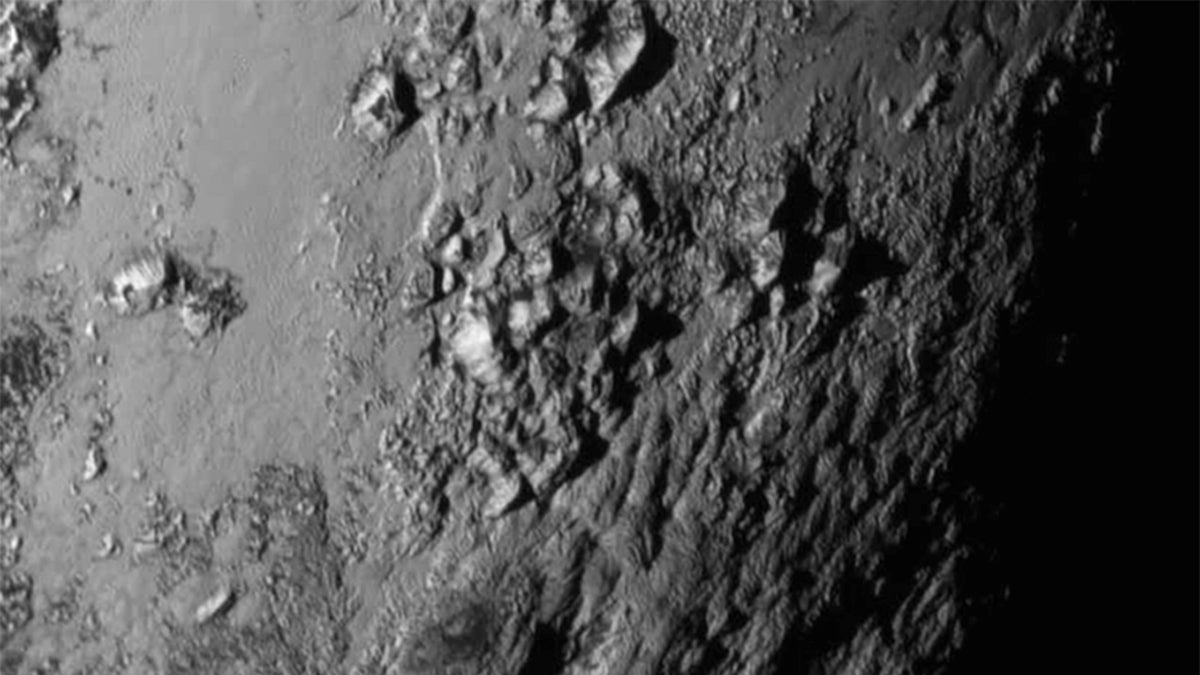Dramatic photos of Pluto provide science fodder for years to come
Listen
This image provided by NASA on Wednesday shows a region near Pluto's equator with a range of mountains captured by the New Horizons spacecraft. (NASA/JHUAPL/SwRI via AP)
New Horizons spacecraft is beaming back images of the solar system’s most distant planet, and scientists think they will answer many questions.
With images from the New Horizons spacecraft finally arriving here on Earth, Pluto is having a moment. Don’t believe me? Just check the Twitter hashtag #PlutoFlyBy.
As a longtime Pluto watcher, MIT professor of planetary science Richard Binzel is also having a moment.
He’s been obsessed with the stars (or in his case, the planets) since he first saw Saturn’s rings through a telescope at age 12. As a scientist on the New Horizons mission, he’s waited almost a decade to see photos of our solar system’s most distant celestial body.
“We’ve been waiting for nine years, and they are beyond expectation,” he told The Pulse.
The images are revelatory for folks in Binzel’s line of work. Soaring ice mountains, fields of light and darkness, and five-mile-deep canyons are some of the spectacular landscapes New Horizons has shown us since the first up-close images arrived on Wednesday night.
“We’re going to be challenged for years ahead trying to decode what this all means,” says Binzel, practically buzzing from all the new data coming his way over the course of the next 16 months or so. That’s how long it will take to send the information three billion miles across the galaxy at the snail’s pace of one kilobyte per second.
“You can think of this process as the longest download in history,” says Binzel. “We’ll never complain again about downloading an HD movie.”
Binzel and others hope the photos will answer some big questions, like might we find life on Pluto?
“Certainly not life as we know it,” Binzel chuckles before continuing, “though we do find life in some very extreme environments on Earth, whether it’s deep in Antarctic ice cores or in hot springs like at Yellowstone.”
And as far as the debate over planetary status is concerned, Binzel is not interested in the controversy.
“We always think of it as a planetary world, and we don’t care too much about the label,” he says dismissively. “It’s a dwarf planet, our sun is a dwarf star, so we think of dwarf planets as plants with all equal standing no matter what you call it.”
With Pluto now in the rearview mirror, we wondered what’s next for New Horizons. A lot, according to Binzel. If NASA approves a continuation of the mission, he says the team has identified some objects in the lesser-known Kuiper Belt of asteroids that are of interest.
Why dedicate your life to a planet so distant that the temperature on a sunny day is 280 degrees below zero?
“These are reachable worlds,” answered Binzel. “You can formulate ideas with telescopes on Earth, and then ultimately go there and resolve those questions you once had and then formulate new questions based on the amazing things that you see up close.”
WHYY is your source for fact-based, in-depth journalism and information. As a nonprofit organization, we rely on financial support from readers like you. Please give today.



